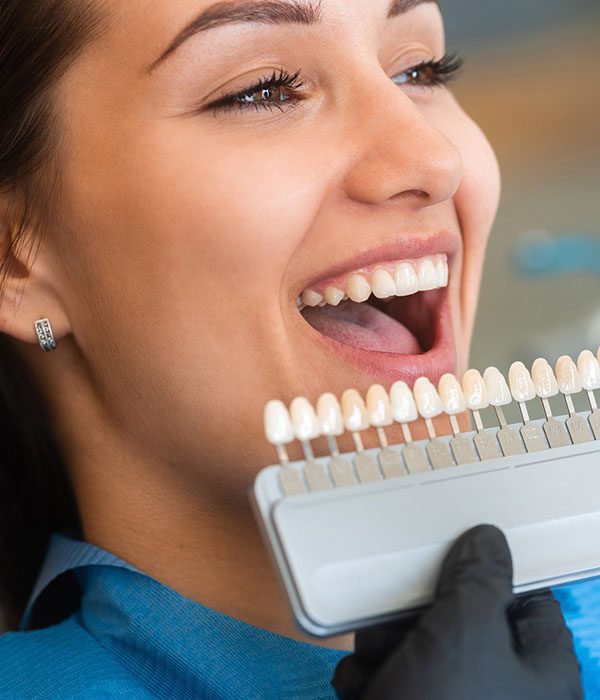Veneers
Overview of Tooth Veneers
Often an alternative to crowns, veneers are very thin pieces of specially-shaped porcelain or plastic that are glued over the front of your teeth with little or no anesthesia needed. They are the cure for teeth that are severely discolored, chipped, have small holes or pits, are misshapen or crooked, or for the correction of unwanted or uneven spaces. Unlike crowns, veneers won’t require the dentist to remove much of the tooth itself in most cases. It is important to ask your cosmetic dentist how many teeth will be removed. In some cases, more teeth will need to be removed, which may increase the risk of trauma to the tooth. Veneers are created from an impression taken in your cosmetic dentist’s office. Your custom veneer is then glued directly onto your tooth. Typically costing less than crowns, veneers won’t stain, making veneers a very popular solution for many people seeking that perfect smile. Strong and very durable, veneers last from ten to fifteen years, and come in colors that will brighten dark teeth without the worry of them changing color.

How Are Tooth Veneers Attached to Your Tooth?
In your first appointment, it is important to initially discuss with your cosmetic dentist that you will want to “try in” your veneers with temporary cement that is the same color cement as will be used for the permanent attachment. During this “try-in” phase, be sure to look at your veneers in natural light in addition to the office light. Teeth are prepared for veneers by lightly buffing to allow for the small added thickness of the veneer. Veneers are thin like contact lenses, and will usually only need tooth reduction of 0.5mm to 1.0mm. If a drastic change is being made for the result you want, the reduction may be 1.0mm to 2.0mm. A mold is taken of the teeth, from which the veneers are modeled. Temporary veneers will be placed and worn until your permanent veneers are ready. While wearing the temporary veneers, advise your cosmetic dentist of any adjustments or changes you would like made, such as in shape or size. These changes will be translated into your permanent veneers, so good communication between you and your dentist is important in achieving your new smile. Your dentist places the veneers with water or glycerin on the teeth to verify their perfect fit and shade or color. The color cannot be changed after the veneers have adhered to your teeth. The tooth is then cleansed with chemicals to achieve a durable bond. Once the glue is between the veneer and your tooth, a light beam is used to harden the glue/cement.
Traditional Porcelain Veneers typically cost between $900 – $2,500 per tooth and require two or more visits one to two weeks apart. Veneers made of porcelain provide greater longevity than plastic, typically ten years to fifteen years or more. Composite Veneers cost significantly less, around $250 per tooth or more, but only last from five to seven years typically. Lumineer Porcelain Veneers typically cost between $700 – $1,000 per tooth and also require just two visits. Lumineers are expected to last as long as traditional porcelain veneers. Generally speaking, the price of tooth veneers and whitening increases with the number of in-office treatments required by the patient. Dental insurance does not typically cover the cost of the tooth veneer procedure. The cost will vary depending on your region, the skill level of your Cosmetic Dentist, and the quality of the lab they use. Traditional Porcelain Veneers typically cost between $900 – $2,500 per tooth and require two or more visits one to two weeks apart. Veneers made of porcelain provide greater longevity than plastic, typically ten years to fifteen years or more. Composite Veneers cost significantly less, around $250 per tooth or more, but only last from five to seven years typically. Lumineer Porcelain Veneers typically cost between $700 – $1,000 per tooth and also require just two visits. Lumineers are expected to last as long as traditional porcelain veneers. Generally speaking, the price of tooth veneers and whitening increases with the number of in-office treatments required by the patient. Dental insurance does not typically cover the cost of the tooth veneer procedure. The cost will vary depending on your region, the skill level of your Cosmetic Dentist, and the lab they use.
Advantages:
Porcelain veneers are common in creating new smiles and smile makeovers. With porcelain veneers, you can have the smile of your dreams in a very short period of time. Typically veneers are difficult to stain, making veneers a very popular solution for many people seeking that perfect smile. Strong and very durable, veneers last from ten to fifteen years, and come in colors that will brighten dark teeth without the worry of them changing color. Veneers are typically done in only two one-and-a-half-hour-long appointments, and can actually strengthen your tooth.
There is no additional maintenance, other than a follow-up visit to your cosmetic dentist and proper brushing and flossing on a daily basis.
Finally, a whiter smile gives people to whom you are speaking a place to focus and gives you a friendlier appearance.
It takes roughly a week or two of a period of adjustment to get used to your teeth that have been changed in color, size, spacing, and shape. While the very little tooth is removed in most cases, there are situations where more teeth must be removed which increases the risk of trauma to the tooth. The amount of tooth to be removed for the veneers should be discussed with your cosmetic dentist beforehand.
Disadvantages:
It is common to have minor sensitivity after your teeth have been prepared for your veneers while wearing the temporary veneers. Some people can experience a difference in speech, usually pronouncing “s” and “f” sounds. This is corrected through minor adjustments your cosmetic dentist can make to your veneers. Veneers are very reasonable facsimiles of natural teeth, but not perfect replacements for natural teeth. It’s common to see slight variations in the color of veneers upon very close inspection, as with natural teeth. It can take up to a month or two before your new smile feels a part of you.
If you suffer from bruxism, clenching, or grinding of your teeth, veneers can be damaged, chipped, or cracked from this. If you suffer from bruxism, speak with your cosmetic dentist about wearing a mouth guard at night to protect your new smile.
Advantages:
Made of Cerinate porcelain, Lumineers are a new type of porcelain veneer. They are contact lens-thin, roughly .2 mm thick. Little to no tooth reduction in most cases is necessary with this type of veneer and anesthetics or numbing shots are not needed. It is claimed that Lumineers resist micro-leakage and micro-cracking more so than traditional porcelain veneers. Unlike other porcelain veneers, you won’t need to wear temporary veneers until the Lumineers are created. Lumineers are expected to last just as long as traditional porcelain veneers. Lumineers are reversible if no tooth reduction was necessary when they were first done. The cost is less than traditional porcelain veneers.
Disadvantages:
As there is little to no tooth reduction needed for Lumineer porcelain veneers, there is a limit to how much smile correction can be accomplished. This can also lead to bulky appearing and feeling veneers in some cases. Cosmetic Dentists offering Lumineers are specially trained specifically for this type of veneer which means for the time being there are fewer Cosmetic Dentists offering Lumineers.
Veneers, porcelain or plastic, are placed over the front teeth to change the color shape of the teeth. Veneers are ideal for teeth that are too small, too big or have uneven surfaces. It is very common for people to have imperfect teeth, either oddly shaped teeth, chipped teeth, crooked teeth, teeth with small holes in them, or inappropriate sized tooth or teeth that have an odd appearance. Veneers solve such irregularities and create a durable and pleasing smile.
When considering veneers a common question is how white the veneers should be. Usually, the answer is to whiten your natural teeth to either the level of whiteness you want or to the brightest they can be. Your cosmetic dentist will then have the veneers made to that color. Teeth are of course not monochromatic, so typically more than one color is used to create a very natural look. This color variation is critical in avoiding fake or artificial-looking teeth. It is the internal contrast of colors that helps create vitality. The internal play of light on the porcelain in the restoration helps to create this vitality. Surface texture is also very important, and helps to break up light reflections and make the crown or veneer look more natural.
There is no one standard system in the dental field to measure and determine tooth color. The most often heard about, however, is the Vita shade guide. This guide divides tooth color into four basic shade ranges:
- A (reddish brown)
- B (reddish yellow)
- C (gray)
- D (reddish gray).
In the A range, there are five levels of darkness. Ranges B, C, and D, each has four levels.
Not all of your teeth are the same natural color. Usually, your eye teeth tend to be darker than the others, your front teeth are typically the whitest, and your molars tend to be a shade between the two. The goal for everyone is to achieve their individual optimum whiteness while still looking natural.
Most dentists will show you a shade chart (like the above-mentioned Vita Shade Guide) for you to pick from. Keep in mind, with a good cosmetic dentist this is merely a starting point. Other considerations when determining the color of veneers for each patient are your complexion, hair color, the color of your natural teeth, and even your eye color.
